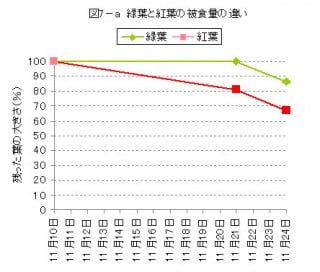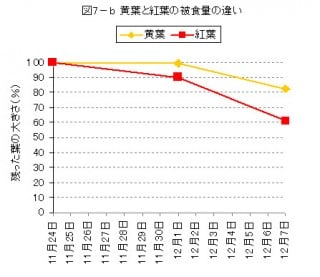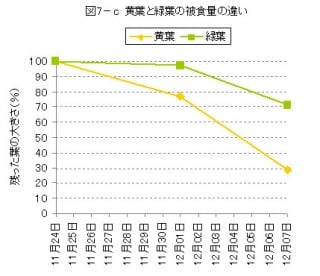What does the deciduous broad-leaved tree turn red for?
In star girl Junior High School of Akira Fukuyama, the high school ECO. club, I repeat experiments under the theme of "what does the deciduous broad-leaved tree turn red for?" from 2008 and am continuing it now.
When it is autumn, the deciduous broad-leaved trees such as cherry trees shed the leaves after having composed Anthozyan using energy expressly, but, about the significance, there is still no established theory.
Enter the field of vision, and we test the relation with various creatures while feeling deep charm in elucidating significance of the working of the plant called colored leaves.
I think that I want you to participate in a person interested in biotechnology and an environmental problem, the field of the innovative drug development by all means.
I introduce below the summary of the conventional experiment.
When it is autumn, the deciduous broad-leaved trees such as cherry trees shed the leaves after having composed Anthozyan using energy expressly, but, about the significance, there is still no established theory.
Enter the field of vision, and we test the relation with various creatures while feeling deep charm in elucidating significance of the working of the plant called colored leaves.
I think that I want you to participate in a person interested in biotechnology and an environmental problem, the field of the innovative drug development by all means.
I introduce below the summary of the conventional experiment.
The hypothesis that is easy to be used as for us to become the nourishment that soil animal and the analyst (bacterias) are better than a green leaf as for the colored leaves about a theme "what does the deciduous broad-leaved tree turn red for?" from 2008,
I thought about "the composting promotion hypothesis of colored leaves" and tested it.
If colored leaves are liked by soil animal and an analyst and are easy to be used, the fallen leaves that came off around a trunk are dismantled fast. As a result, the possibility that inorganic salts produced by fallen leaves are available as own manure will increase before fallen leaves are hit by wind for the plant somewhere.
I performed an experiment to check which extract you multiplied it in among each extract which an experiment to check which of colored leaves, turning yellow, the green leaf soil animals (dumpling insect) ate well and a bacteria, fungi in the soil got from colored leaves, turning yellow, a green leaf well to inspect this hypothesis.
From this experiment, the colored leaves of the deciduous broad-leaved tree understood that they might have action to promote eating due to the soil animal in comparison with a green leaf (figure 1 08 Hiroshima science prize associate choice).
I thought about "the composting promotion hypothesis of colored leaves" and tested it.
If colored leaves are liked by soil animal and an analyst and are easy to be used, the fallen leaves that came off around a trunk are dismantled fast. As a result, the possibility that inorganic salts produced by fallen leaves are available as own manure will increase before fallen leaves are hit by wind for the plant somewhere.
I performed an experiment to check which extract you multiplied it in among each extract which an experiment to check which of colored leaves, turning yellow, the green leaf soil animals (dumpling insect) ate well and a bacteria, fungi in the soil got from colored leaves, turning yellow, a green leaf well to inspect this hypothesis.
From this experiment, the colored leaves of the deciduous broad-leaved tree understood that they might have action to promote eating due to the soil animal in comparison with a green leaf (figure 1 08 Hiroshima science prize associate choice).
As a result of putting a dumpling insect (60) in the bat which I put five pieces of leaves of the cherry tree of two kinds of figure 1 in each, and having checked cover food quantity of the leaf (the autumn of 2008). I understood that there was the most cover food of colored leaves.
Figure 1-a green leaf turns red (bottom)
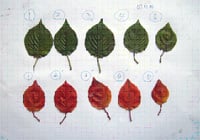
November 10
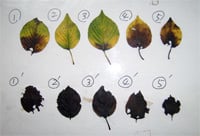
November 21
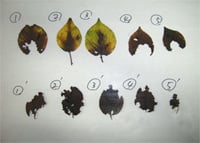
November 24
Figure 1-b turning yellow turns red (bottom)
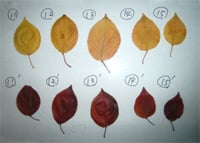
November 24
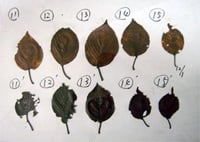
December 1
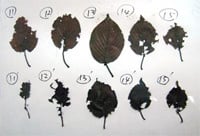
December 7
Figure 1-c turning yellow turns red (bottom)
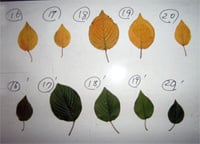
November 24
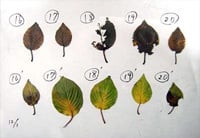
December 1
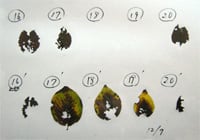
December 7
Difference in quantity of cover food due to the dumpling insect of the leaf of the figure 2 cherry tree (the thing which graphed figure 1)
After the fallen leaves were eaten by soil animal, they become the compost by the resolution of a bacteria, fungi. We thought that the colored leaves might promote the increase of fungi for 2,009 years and checked the extract of the leaf and the relations of the bacteria. I cultured single mold (white mold figure 3) and checked influence of the extract of colored leaves, turning yellow, the green leaf of the cherry tree. It is the mold which stands out most frequently when I observed fallen leaves that chose white mold as the representative of fungi, and this is because it thought that it will play role that is important as an analyst. As a result of experiment, the effect that the extract (each 0.03% of solute density) of the leaf promoted an increase of the white mold turned red and understood a big thing in order of turning yellow, a green leaf (figure 4, figure 5 09 Hiroshima science prize choice containing).
In this experiment, I used a method to count the number of the colony which I was able to refresh for the place except the place that I dropped after by 50μℓ dropping cell body suspension of the white mold in the center of each agar nutrient medium to check the influence that the extract of the leaf of the cherry tree gave for an increase of the white mold, and having left a laboratory dish to stand in a darkroom for 40 hours.
In this experiment, I used a method to count the number of the colony which I was able to refresh for the place except the place that I dropped after by 50μℓ dropping cell body suspension of the white mold in the center of each agar nutrient medium to check the influence that the extract of the leaf of the cherry tree gave for an increase of the white mold, and having left a laboratory dish to stand in a darkroom for 40 hours.
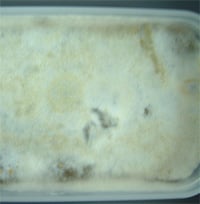
White mold on the figure 3 agar nutrient medium
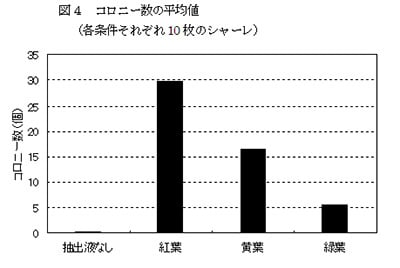
Propagation of white mold on the nutrient medium containing the extract of the figure 5 cherry tree (an example in the plate of each 13 pieces of conditions)

In 2010, I tested it for the purpose of checking influence of the extract of colored leaves, turning yellow, the green leaf of the cherry tree using green mold. As a result, I understood that the turning yellow extract promoted the green leaf extract obstructing an increase of the green mold, an increase of the green mold next to colored leaves with promotion sunoha colored leaves extract most.
The result of the eating experiment due to green mold and white mold (possibility of the Aspergillus oryzae) and the dumpling insect of 2008 supports our hypothesis that named "the composting promotion hypothesis of colored leaves".
"The composting promotion hypothesis of colored leaves" is the following content. Though "humus is deepened 1cm in a forest of nature, it is said that I need time of the unit for 100 years. The organic matter included in fallen leaves is the leading role of the humus formation. The colorful fallen leaves which opened under the tree which shed the leaves in November when colored leaves are bright are often blown off by strong wind overnight. If I promote eating of dumpling insects by the Anthozyan which autumn colors were stored in before fallen leaves and I am crushed finely immediately and join soil as wet excrement, I am not blown off by the wind of the number. And the ingredient of colored leaves left to the body wastes of dumpling insects promotes the resolution due to a bacteria, fungi. As a result, the plant which dropped fallen leaves can obtain inorganic salts-rich the rich soil. About pollen and seminal dispersion, the angiosperm which accomplished Insecta and birds, the coevolution with mammals might build the collaborative relationship with soil animal and fungi, the bacteria by the colored leaves formation about the compost formation"
If the bioactivity of the extraction ingredient of colored leaves becomes clear, it may lead to efficient composting and application as the antibacterial. For example, it is thought that I manufacture the additive for the compost which purifies an active ingredient for composting from the extraction ingredient of colored leaves, and composts garbage efficiently.
"The composting promotion hypothesis of colored leaves" is the following content. Though "humus is deepened 1cm in a forest of nature, it is said that I need time of the unit for 100 years. The organic matter included in fallen leaves is the leading role of the humus formation. The colorful fallen leaves which opened under the tree which shed the leaves in November when colored leaves are bright are often blown off by strong wind overnight. If I promote eating of dumpling insects by the Anthozyan which autumn colors were stored in before fallen leaves and I am crushed finely immediately and join soil as wet excrement, I am not blown off by the wind of the number. And the ingredient of colored leaves left to the body wastes of dumpling insects promotes the resolution due to a bacteria, fungi. As a result, the plant which dropped fallen leaves can obtain inorganic salts-rich the rich soil. About pollen and seminal dispersion, the angiosperm which accomplished Insecta and birds, the coevolution with mammals might build the collaborative relationship with soil animal and fungi, the bacteria by the colored leaves formation about the compost formation"
If the bioactivity of the extraction ingredient of colored leaves becomes clear, it may lead to efficient composting and application as the antibacterial. For example, it is thought that I manufacture the additive for the compost which purifies an active ingredient for composting from the extraction ingredient of colored leaves, and composts garbage efficiently.
There is not yet an established theory, but, about the meaning that the leaf of the plant accumulates Anthozyan, the T.S.Feild (2001) and others announce the following new opinion. When "it is autumn, and temperature falls, the metabolism activity gradually decreases with the leaf of the fallen leaves plant. Waste materials collect to the thing which I can reuse in nourishment included in there before a leaf falls while I collect it as much as possible. The resolution begins in the chloroplast which is the photosynthetic place of the leaf, and chlorophyll becoming the nucleus comes out from a husk. It becomes the excited state that absorbed energy when only chlorophyll which is the central existence goes out and receives light from chloroplastic structure and I pressure oxygen existing in the outskirts to work on it directly and create very toxic active oxygen. (I photooxidize it and affect it) and efficiency of the collection work of the nutrition left on the leaf that the structure of the cell of the leaf is changed into by action of the active oxygen largely decrease. It becomes at low risk of the active oxygen generation if I shut out the light of the most efficient blue from chlorophyll in photosynthesizing. Degree to receive a photooxidation disorder when I exposed the light that is strong with a result that anthocyanin absorbs light of the blue well and controls excitation of chlorophyll, the leaf which turned red red lowers than a yellow leaf"
It is thought about enough the colored leaves formation having plural significance including prevention and the composting promotion of the photooxidation obstacle. I want to repeat experiments about other bacterias, fungi in future.
Reference
・"The deciduous broad-leaved tree turning red for what" or the 52nd Hiroshima science prize choice (star girls' high school of Akira Fukuyama) containing
・The 53rd "increase suppressant effect of an increase promotion effect and the Bacillus natto of the white mold with the extract of colored leaves" Hiroshima science prize choice (star girls' high school of Akira Fukuyama) containing
・Written by Peter Thomas, Minoru Kumazaki other reason "dendrology" Tsukiji book building (2001)
・Good luck ball country Jiro Japanese Society of Plant Physiologists "open space of all" http://www.jspp.org/17hiroba
・Written by Ryoichi Yamamoto, "introduction to plant physiology" Ohmsha (2007)
・T.S.Feild et al., "Why leaves turn red in autumn", Plant Physiology, 127, pp .566-574 (2001)
・"The deciduous broad-leaved tree turning red for what" or the 52nd Hiroshima science prize choice (star girls' high school of Akira Fukuyama) containing
・The 53rd "increase suppressant effect of an increase promotion effect and the Bacillus natto of the white mold with the extract of colored leaves" Hiroshima science prize choice (star girls' high school of Akira Fukuyama) containing
・Written by Peter Thomas, Minoru Kumazaki other reason "dendrology" Tsukiji book building (2001)
・Good luck ball country Jiro Japanese Society of Plant Physiologists "open space of all" http://www.jspp.org/17hiroba
・Written by Ryoichi Yamamoto, "introduction to plant physiology" Ohmsha (2007)
・T.S.Feild et al., "Why leaves turn red in autumn", Plant Physiology, 127, pp .566-574 (2001)
